11 Species of Woodpeckers in Washington (with Pictures)
Last Updated on
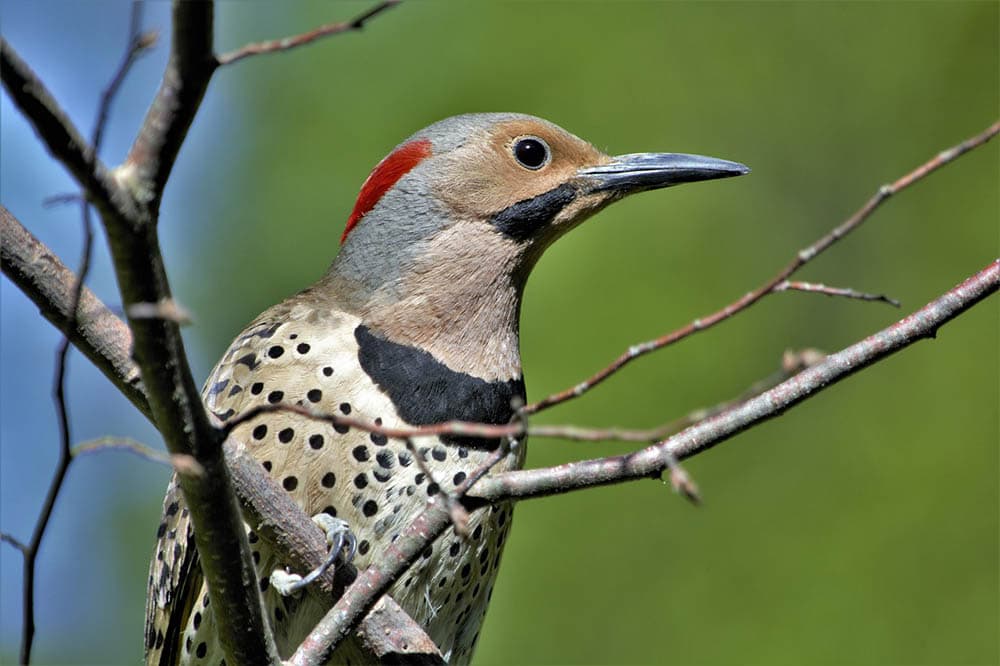
With their distinctive knocking noise against trees and sometimes metal pipes, woodpeckers are among the most noticeable bird species in the world. Washington is no stranger to these birds either, and woodland areas — especially forests burned in recent wildfires — are often home to many species of woodpeckers.
While not all the woodpeckers on this list are easy to find, they all have unique appearances and behavior. Whether you spot them pecking away at your bird feeder or stumble across them on a woodland hike, their bright colors and distinctive personalities make them intriguing birds to watch.

The 11 Species of Woodpeckers in Washington
1. American Three-Toed Woodpecker

| Scientific Name: | Picoides dorsalis |
| Wingspan: | 14.6–15.3 inches |
| Size: | 8.3–9.1 inches |
Found in only a few places throughout Washington, the American Three-Toed Woodpecker favors disturbed woodlands over dense forests. Drawn to burned areas in particular — usually within 8 years following the wildfire — American Three-Toed Woodpeckers chip away at the bark of dead trees to reach the insect larvae underneath.
This bird is similar in appearance to the Black-Backed Woodpecker but is smaller and has a white patch or spots on their back. The male has a yellow patch on their forehead, while the female is a more subdued mix of black and white.
As an opportunistic hunter of beetles, this species often travels out of their usual areas to take advantage of outbreaks in the beetle population. They also travel farther north than any of the other woodpeckers in the U.S.A.
2. Black-Backed Woodpecker
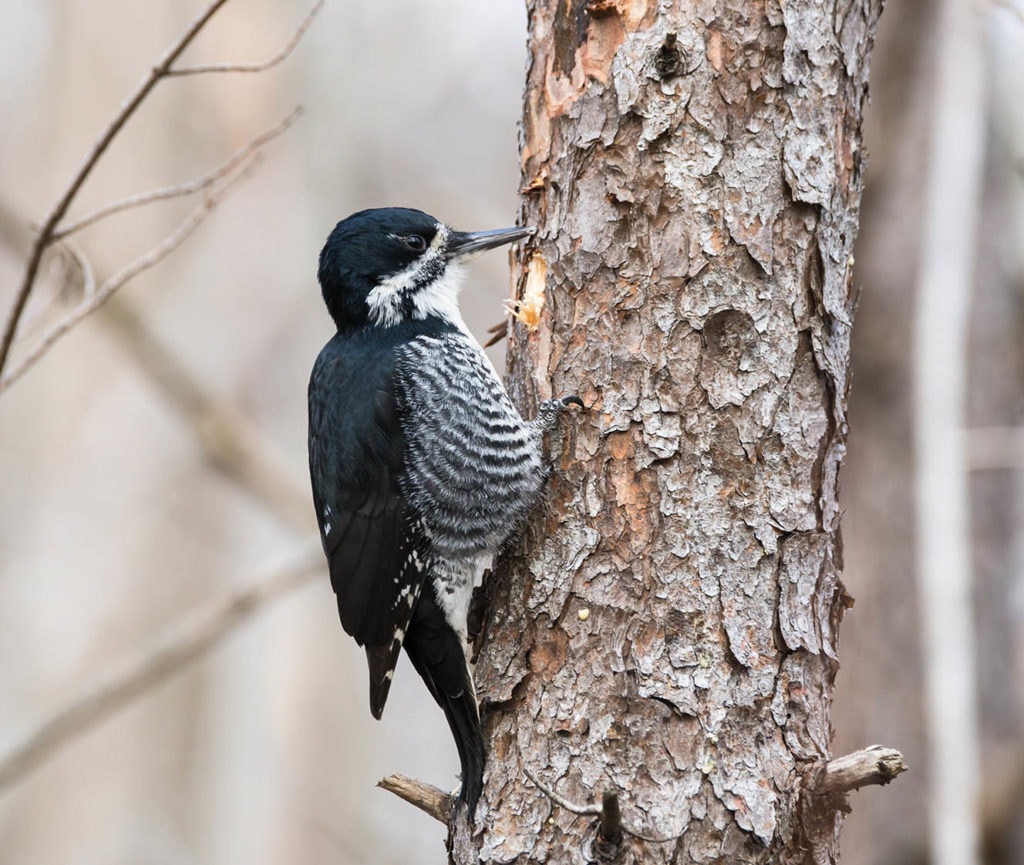
| Scientific Name: | Picoides arcticus |
| Wingspan: | 15.8–16.5 inches |
| Size: | 9.1 inches |
With their similar distribution and appearance to the American Three-Toed Woodpecker, it’s easy to mistake the Black-Backed Woodpecker as their smaller cousins. The species is found in the same burned forests in many of the same areas around Washington for the whole year. The drumming pattern of the Black-Backed Woodpecker is also similar in the way that it trails off at the end. However, their large size and completely black back, along with the single white stripe on their face, are all key identifying features of the Black-Backed Woodpecker.
Like the American Three-Toed Woodpecker and the Eurasian Three-Toed Woodpecker, the Black-Backed Woodpecker has three toes rather than the usual four of other woodpecker species.
3. Downy Woodpecker
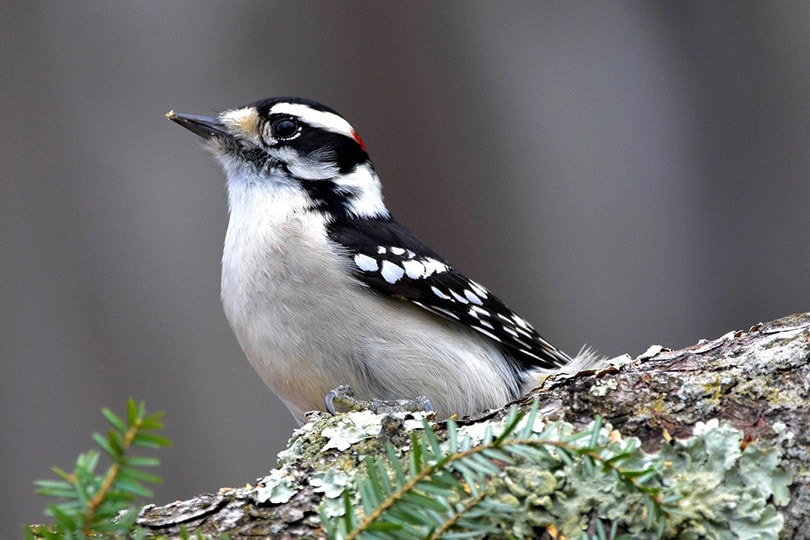
| Scientific Name: | Dryobates pubescent |
| Wingspan: | 9.8–11.8 inches |
| Size: | 5.5–6.7 inches |
The smallest woodpecker found in Washington, the Downy Woodpecker is often mistaken for the larger Hairy Woodpecker due to their almost identical appearances. They share the same black-and-white feathers, along with the red patch on the back of their head.
Downy Woodpeckers are common sights throughout Washington all year round and are especially fond of backyard bird feeders, parks, and woodland areas. They also often join flocks of Chickadees and Nuthatches, especially during the winter months when food is scarce. As one of the smaller woodpecker species, they’re barely larger than the flocks that they spend time with.
4. Hairy Woodpecker
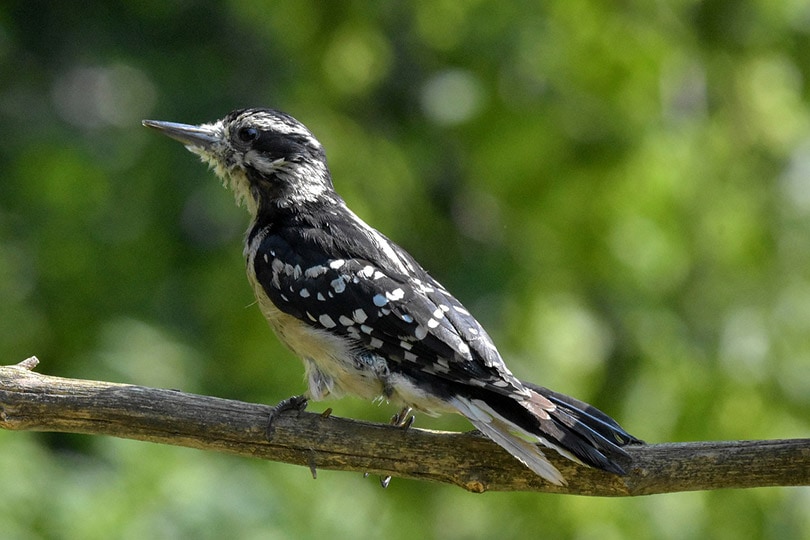
| Scientific Name: | Dryobates villosus |
| Wingspan: | 13–16.1 inches |
| Size: | 7.1–10.2 inches |
The Hairy Woodpecker’s black wings with white spots, striped face, and red patch on the back of the male’s head make this bird a challenge to distinguish from the Downy Woodpecker. They also favor the same backyard bird feeders, parks, and woodland areas.
Telling these species apart can be a challenge and takes a keen eye. The differences lie in the Hairy Woodpecker’s longer bill and larger size. Pay close attention to their behavior too. Hairy Woodpeckers have been described as “soldierly,” with a straight-backed posture as they perch on tree trunks.
5. Lewis’s Woodpecker

| Scientific Name: | Melanerpes lewis |
| Wingspan: | 19.3–20.5 inches |
| Size: | 10.2–11 inches |
Unlike other woodpeckers, you’re not likely to find a Lewis’s Woodpecker digging into a tree trunk in search of insects. Instead, their diet consists of flying insects that they catch in midair. They’re also not a common sight, being a seasonal visitor for the late spring and early summer breeding season. You can find them in burned forests and among ponderosa pines.
Despite their limited presence in Washington, they’re easy to recognize. They have a long bill, red-and-black face, gray neck, dark-green back and wings, and a pinkish-red undercarriage. They also have a crow-like flight pattern.
6. Northern Flicker

| Scientific Name: | Colaptes auratus |
| Wingspan: | 16.5–20.1 inches |
| Size: | 11–12.2 inches |
One of the larger woodpeckers found in Washington, the Northern Flicker is a year-round resident of the state and often doesn’t behave like their woodpecker cousins. While other woodpeckers will dig for food in tree trunks, the Northern Flicker prefers to forage for ants and beetles on the ground. They also favor open woodland and the edges of forests.
Mostly brown, they have a black-scalloped plumage. There are two varieties, and you can recognize them based on the accents on their wings. Yellow-Shafted Northern Flickers have black mustache stripes and yellow accents on the wings and are found in the eastern parts of the U.S.A. Red-Shafted Northern Flickers are found in Washington and the western U.S.A. and have red mustache stripes and red accents on the wings.
7. Pileated Woodpecker
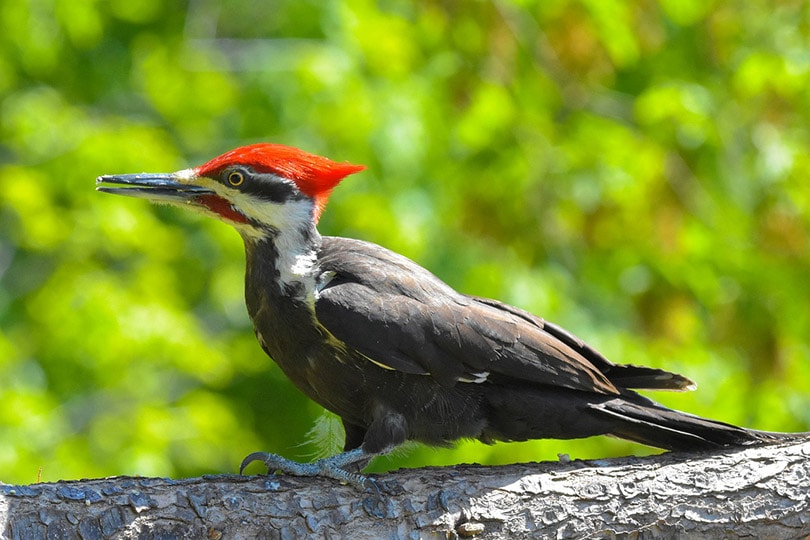
| Scientific Name: | Dryocopus pileatus |
| Wingspan: | 26–29.5 inches |
| Size: | 15.8–19.3 inches |
As the biggest woodpecker in the U.S.A. with a striking red crest, black-and-white striped face, and black body, the Pileated Woodpecker is relatively easy to recognize. They make their home in northern, western, and eastern Washington year round but can be difficult to see due to their preference for forests with plenty of fallen and dead trees.
The Pileated Woodpecker leaves rectangular-shaped holes in trees where they feed, and these crevices often draw other bird species — Woodpeckers and House Wrens, in particular — to the site. They’re often incredibly territorial but sometimes allow other birds into their territory during the winter months.
8. Red-Breasted Sapsucker
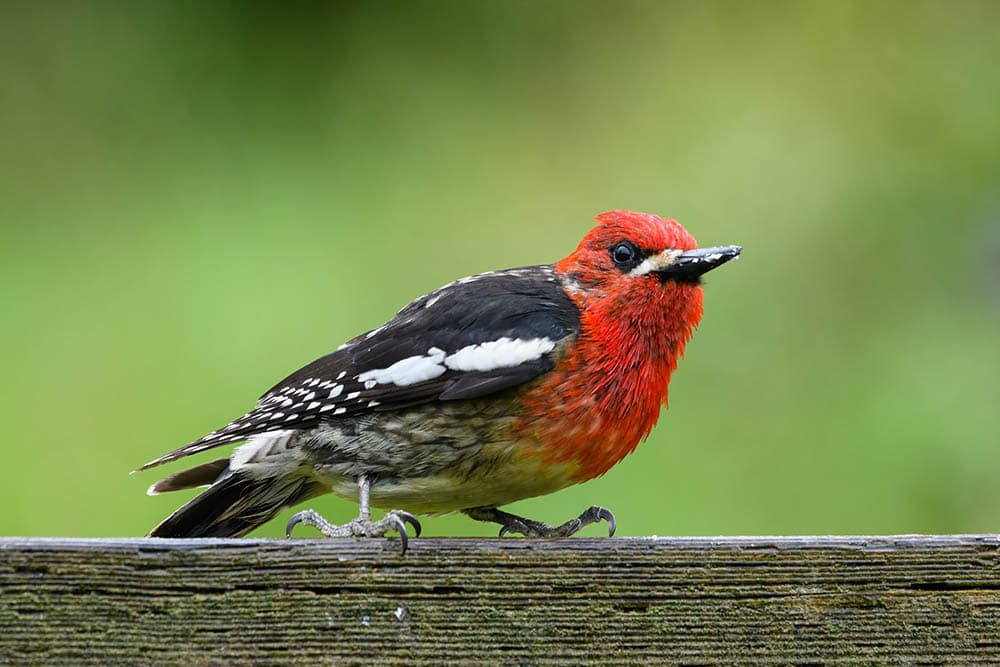
| Scientific Name: | Sphyrapicus ruber |
| Wingspan: | 14.6–16 inches |
| Size: | 7.9–8.7 inches |
Recognized by their scarlet head, dark-checkerboard patterning on their back, and gray underside, the Red-Breasted Sapsucker is a year-round resident of western Washington. Like other sapsuckers, they dig shallow holes into trees to eat the sap and often help encourage other sap-eating creatures to stay in the area. They prefer coniferous forests but can be found around other trees during winter.
Red-Breasted Sapsuckers are often accompanied by Rufous Hummingbirds, which take advantage of their sap wells to feed themselves. Red-Breasted Sapsuckers also interbreed with Red-Naped Sapsuckers, so their offspring can be difficult to properly identify.
9. Red-Naped Sapsucker

| Scientific Name: | Sphyrapicus nuchalis |
| Wingspan: | 16.1–16.9 inches |
| Size: | 7.5–8.3 inches |
Only found in eastern Washington during the summer, the Red-Naped Sapsucker is relatively easy to identify. They have black wings with white patterning, a gray belly with yellow patches, and red patches on their throat and head. The female can be identified by the white patch breaking up the red of their throat.
Most active in the early morning and breeding season, the Red-Naped Sapsucker is commonly found around willow and alder trees. Like other sapsuckers, they leave shallow sap wells in the trunks of living trees.
The species is closely related to the Red-Breasted and Yellow-Bellied Sapsuckers. All three were mistaken for the same species until the early 1980s.
10. Williamson’s Sapsucker

| Scientific Name: | Sphyrapicus thyroideus |
| Wingspan: | 13–15 inches |
| Size: | 8.3–9.8 inches |
Unlike the males and females of most other woodpeckers, the female Williamson’s Sapsucker looks nothing like the male. Their appearance is so different, in fact, they were first believed to be a separate species.
The male has a typical woodpecker appearance with a black body, white wing patches, striped face, red throat, and yellow underbelly. The female Williamson’s Sapsucker has a banded back, patches of yellow and black on their belly, and a brown head.
Williamson’s Sapsuckers aren’t found in many places in Washington and are often only seen during the breeding season. They can be found in both mountain and coniferous forests. Their raptor-like call is often one of the first things that give this species away.
11. White-Headed Woodpecker

| Scientific Name: | Dryobates albolarvatus |
| Wingspan: | 16.9 inches |
| Size: | 8.3–9.1 inches |
While many other woodpeckers found in Washington have bright colors to make them easy to recognize, the White-Headed Woodpecker’s appearance is a little subtler. Except for the white patch on their wings and their white head, they’re completely black, with the male sporting a red patch on the top of their head. They’re also quiet when they forage and might be easier to hear during the spring.
Found almost exclusively in the western states, although in only small areas, the White-Headed Woodpecker can be seen in Washington all year round. They prefer pine forests in mountainous regions and burned woodland, and they sometimes frequent backyard bird feeders in these areas.

In Conclusion
Announced by their distinctive knocking, woodpeckers are brightly colored additions to many burned woodlands, where they feast on insects or even backyard bird feeders. Many of the species are similar in appearance, requiring a discerning eye to tell the difference between them.
The similarities and differences in appearance and behaviors make these birds an interesting challenge for new bird watchers to identify. We hope that this guide has helped you figure out which woodpeckers you can find throughout Washington.
Featured Image Credit: Scottslm, Pixabay
Table of Contents
About the Author Robert Sparks
Robert’s obsession with all things optical started early in life, when his optician father would bring home prototypes for Robert to play with. Nowadays, Robert is dedicated to helping others find the right optics for their needs. His hobbies include astronomy, astrophysics, and model building. Originally from Newark, NJ, he resides in Santa Fe, New Mexico, where the nighttime skies are filled with glittering stars.
Related Articles:
Monocular vs Telescope: Differences Explained (With Pictures)
10 Types of Hummingbirds in Arkansas (With Pictures)
8 Types of Hummingbirds in Nebraska (With Pictures)
5 Types of Hummingbirds in Idaho (With Pictures)
3 Types of Hummingbirds in Mississippi (With Pictures)
8 Types of Hummingbirds in Kansas (With Pictures)
5 Types of Hummingbirds in West Virginia (With Pictures)
5 Types of Hummingbirds in Ohio (With Pictures)
